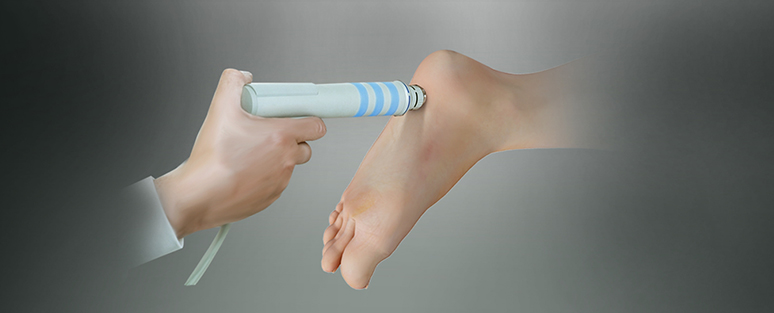
Heel pain can impact daily activities such as walking, running, or even standing for extended periods. While plantar fasciitis often takes center stage as the primary cause of heel pain, it's essential to recognize that heel discomfort can stem from various factors. If you are struggling with heel pain, this article will shed light on the diverse origins of heel pain and clarify why some cases prove to be persistent challenges. In this comprehensive guide, you’ll learn about the causing factors of heel pain, and gain valuable insights tailored to both patients and healthcare professionals.
Understanding the Complex Heel Pain Landscape
Heel pain can be a debilitating and relentless issue, affecting the quality of life for countless individuals. While plantar fasciitis often grabs the headlines, it represents just one piece of the complex puzzle that is heel pain. To truly comprehend the nuances of heel pain, we must explore several potential suspects that cause pain at the back or bottom of the heel:
- Plantar Fasciitis: Plantar fasciitis is characterized by the inflammation of the plantar fascia, a strong band of tissue that runs from the heel to the toes. It often appears as a searing, stabbing pain in the heel and ranks as the most prevalent cause of plantar (bottom) heel pain.
- Insertional Achilles Tendinitis: This condition involves the inflammation of the Achilles tendon at it inserts at the back of the heel, the crucial link between calf muscles and the foot and ankle. It can cause pain at the back of the heel and is a common grievance among athletes and the physically active.
- Gastrocnemius Tightness: Tightness of the calf muscle can cause strain and pain at the Achilles tendon insertion at the back of the heel and fascia extending to the bottom of the heel.
- Heel Spurs: On occasion, calcium can be deposited, or bone can form on the back of and beneath the surface of the heel bone, leading to the development of bony growths known as heel spurs. Although they are often associated with plantar fasciitis or Insertional Achilles tendinitis, this condition can grow large enough to cause problems and discomfort, especially when you're on your feet or even during rest due to pressure or shoes.
- Stress Fractures: Microscopic fractures can appear in the heel bone, often a symptom of overuse or repetitive stress. These microfractures, though small, can result in significant pain, predominantly affecting training athletes, or individuals in physically demanding occupations.
- Bursitis: Inflammation can appear in the bursa sac, a cushion filled with fluid located near the heel and Achilles tendon, giving rise to tenderness and discomfort in the heel region.
- Nerve Entrapment: Conditions such as Baxter's neuritis can induce heel pain by compressing the plantar nerve as it courses under the heel, and can mimic plantar fasciitis.
- Systemic Conditions: Systemic factors can also influence heel pain. Problems such as gout, rheumatoid arthritis, and certain spondyloarthropaties are known to manifest with heel pain as a telltale sign.
Persistent Heel Pain: Unraveling the Mystery
Now that we've covered the variety of heel pain causes, it's important to confront the mystery of why heel pain stays, despite diligent treatment. This scenario can be a source of immense frustration for both patients and healthcare providers. Numerous factors may contribute to this:
- Misdiagnosis: Although the vast majority of heel pain is usually plantar fasciitis, other causes can be notoriously misdiagnosed as plantar fasciitis when the source of pain lies elsewhere. Accurate diagnosis is the cornerstone of effective treatment.
- Delayed Treatment: Ignoring heel pain or delaying proactive treatment can give rise to chronic inflammation and structural alterations within the foot. Timely intervention is crucial to avoid long-term complications.
- Inadequate Treatment: Heel pain treatment spans a wide range, tailored to the specific underlying cause. Generic treatments will often fail to address the underlying issues causing the pain. Collaborative consultations between patients and healthcare providers allow for personalized treatment plans.
- Overuse or Re-Injury: Athletes and individuals involved in strenuous activities may not take adequate time for recovery, inviting re-injury and persistent pain.
- Biomechanical Factors: Abnormal foot anatomy and gait can contribute to persistent heel pain. Custom orthotics or physical therapy may be required to address these intricate issues. Some abnormal biomechanical factors such as chronic Achilles Ruptures or Gastrocnemius Contractures may require additional treatment.
- Chronic Conditions: Some conditions, particularly autoimmune or inflammatory conditions such as rheumatoid arthritis, ankylosing spondylitis, or nerve entrapment, demand ongoing management to control symptoms, making heel pain an enduring companion.
Treatment and Prevention: A Path to Relief
Conquering heel pain, regardless of its origin, often requires a comprehensive approach that combines conservative measures with potential surgical intervention. To effectively manage and prevent heel pain, consider these practical tips.
Conservative Intervention: At the onset of heel pain.
- Rest is crucial; avoid activities that exacerbate the pain, giving your heels the time they need to heal and recover.
- Orthotics, whether custom-made or over-the-counter, can provide essential support, reducing the strain on your heels and enhancing comfort.
- Regular stretching exercises, whether for the calf muscles or the plantar fascia, can help maintain flexibility and release tension around the heel.
- Medications like nonsteroidal anti-inflammatory drugs (NSAIDs) can help alleviate both pain and inflammation, but it's advisable to consult with your healthcare provider before using them. Autoimmune or chronic medical conditions may require treatment of the primary problem by a medical doctor such as a rheumatologist or primary medical doctor, as well as managing the heel pain, for the best outcome.
- Proper footwear is essential; choose shoes with robust arch support and ample cushioning, especially if your daily activities involve prolonged periods of standing or walking.
- Weight management is crucial; excess body weight can increase the pressure on your feet, potentially worsening heel pain, which can then make exercise even more difficult. Maintaining a healthy weight is crucial in preventing its onset and reducing its severity. By incorporating these strategies into your daily routine and seeking professional guidance when necessary, you can take proactive steps toward managing and preventing heel pain, allowing you to maintain an active and pain-free lifestyle. If there is too much pain to allow for effective exercise for weight loss, consult with your doctor to break the cycle.
Aggressive Non-operative Intervention: Pain that is persisting or is out of proportion, may require additional assessment with your orthopedic surgeon for x-rays and physical examination.
- Physical therapy guided by a professional, involves stretches and targeted exercises that can strengthen the muscles in your feet and improve your gait, acting as a safeguard against the recurrence of heel pain. Additionally, assessment of altered gait and mechanics can be an important component of physical therapy.
- Shock-Wave Therapy is a non-surgical treatment that can help to stimulate the healing of chronic tendonitis or plantar fasciitis that is not responding to conservative measures or physical therapy.
- PRP injections are an in-office, non-surgical procedural intervention that uses the body's healing factors to help stimulate the healing of stubborn, recalcitrant tendonitis or fasciitis, and help patients turn the corner.
Surgical Interventions: Surgery is rare and is only reserved as the absolute last resort.
For those very few patients that are not improved with the interventions listed above, have severe difficulty walking, and due to a structural issue such as a fracture that is worsening, a significant tendon tear that is not healing, or nerve entrapment that is not alleviated conservatively. The goal is always a return to function, and for most patients, conservative and aggressive non-operative interventions can achieve that goal.
Conclusion
Heel pain can be confusing and challenging, but it's important to understand that plantar fasciitis isn't the only factor. Always consult with your orthopedic surgeon for an accurate diagnosis and individualized treatment plan.
Click Here to schedule a consultation with Dr. Natalie Mesnier at Multnomah Orthopedic Clinic. Your orthopedic health is her priority.












